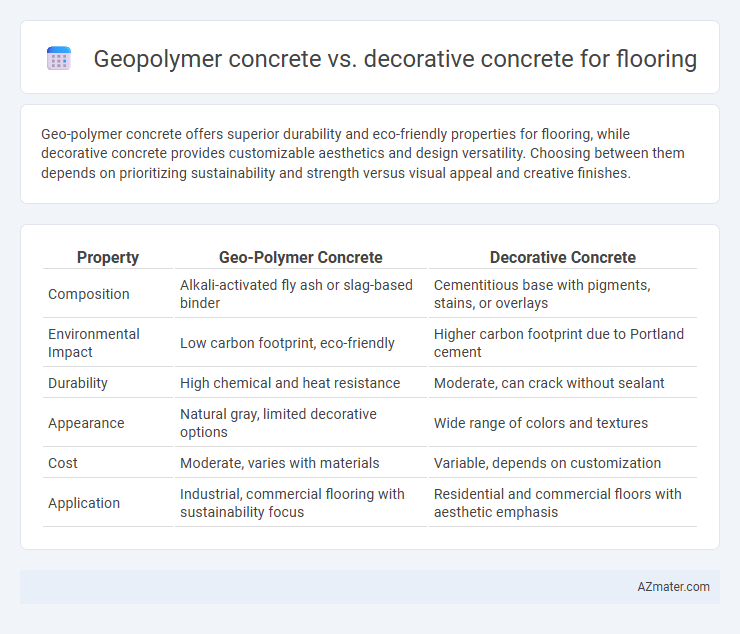Geo-polymer concrete offers superior durability and eco-friendly properties for flooring, while decorative concrete provides customizable aesthetics and design versatility. Choosing between them depends on prioritizing sustainability and strength versus visual appeal and creative finishes.
Table of Comparison
| Property | Geo-Polymer Concrete | Decorative Concrete |
|---|---|---|
| Composition | Alkali-activated fly ash or slag-based binder | Cementitious base with pigments, stains, or overlays |
| Environmental Impact | Low carbon footprint, eco-friendly | Higher carbon footprint due to Portland cement |
| Durability | High chemical and heat resistance | Moderate, can crack without sealant |
| Appearance | Natural gray, limited decorative options | Wide range of colors and textures |
| Cost | Moderate, varies with materials | Variable, depends on customization |
| Application | Industrial, commercial flooring with sustainability focus | Residential and commercial floors with aesthetic emphasis |
Introduction to Geo-Polymer and Decorative Concrete Flooring
Geo-polymer concrete flooring utilizes inorganic polymers derived from industrial byproducts like fly ash, resulting in high durability, chemical resistance, and low carbon footprint compared to traditional cement-based materials. Decorative concrete flooring encompasses techniques such as stamping, staining, and polishing to create visually appealing surfaces with customizable patterns and colors, often used in commercial and residential spaces for aesthetic enhancement. Both materials offer unique advantages where geo-polymer concrete emphasizes sustainability and strength, while decorative concrete prioritizes versatility and design flexibility.
Composition and Material Differences
Geo-polymer concrete utilizes industrial by-products like fly ash or slag activated by alkaline solutions, creating a sustainable binder that reduces carbon emissions compared to traditional Portland cement. Decorative concrete incorporates polished aggregates, pigments, and surface treatments such as stains, dyes, or stamped patterns, emphasizing aesthetic appeal rather than structural composition. While geo-polymer concrete prioritizes eco-friendly, high-performance materials, decorative concrete focuses on customizable textures and colors for enhanced visual impact in flooring applications.
Environmental Impact and Sustainability
Geo-polymer concrete significantly reduces carbon emissions by utilizing industrial by-products like fly ash and slag, offering a sustainable alternative to traditional Portland cement-based decorative concrete. Its low embodied energy and ability to incorporate recycled materials contribute to minimizing environmental impact and supporting green building certifications. Decorative concrete, while aesthetic and durable, often relies on conventional cement mixes with higher carbon footprints and less potential for waste reutilization, making geo-polymer concrete a more eco-friendly choice for sustainable flooring solutions.
Performance and Durability Comparison
Geopolymer concrete offers superior chemical resistance and high thermal stability compared to decorative concrete, making it ideal for industrial flooring exposed to harsh environments. Its enhanced durability stems from the use of industrial by-products like fly ash, resulting in lower permeability and increased long-term strength. Decorative concrete provides versatile aesthetic options but generally exhibits lower abrasion resistance and lifespan under heavy mechanical stress.
Aesthetic Versatility and Design Options
Geo-polymer concrete offers extensive aesthetic versatility with its ability to mimic natural stone, incorporate vibrant pigments, and achieve various textures through mix modifications, making it a sustainable choice for creative flooring designs. Decorative concrete excels in design options by utilizing stamping, staining, and overlays to produce intricate patterns, realistic looks, and customized finishes that cater to diverse architectural styles. Combining durability and customizable appearance, both materials provide dynamic solutions to meet unique aesthetic demands in modern flooring projects.
Installation Process and Techniques
Geo-polymer concrete flooring requires precise mixing of industrial by-products like fly ash with alkaline activators, demanding controlled curing conditions to achieve its high strength and durability. Installation involves careful layering and compaction, often needing specialized equipment to maintain temperature and moisture levels during curing. Decorative concrete flooring, by contrast, relies on techniques such as stamping, staining, or polishing applied to traditional concrete mixes, allowing for faster installation and more flexible aesthetic customization with standard curing processes.
Cost Analysis and Long-term Value
Geopolymer concrete typically offers lower lifecycle costs due to its enhanced durability and resistance to chemical attack, reducing maintenance expenses over time compared to decorative concrete, which may require frequent resealing and repairs to maintain appearance. Initial installation costs for decorative concrete are often higher because of customization, pigments, and finishes, whereas geopolymer concrete leverages sustainable, industrial by-products like fly ash, lowering material costs. Long-term value of geopolymer concrete flooring exceeds that of decorative options by providing superior strength and environmental benefits, making it a cost-effective solution for industrial and commercial applications.
Maintenance Requirements and Lifespan
Geopolymer concrete flooring offers superior chemical resistance and minimal maintenance due to its dense microstructure, resulting in a lifespan exceeding 50 years under normal conditions. Decorative concrete flooring, while visually appealing and customizable with stains or overlays, generally requires more frequent sealing and repairs, reducing its effective lifespan to around 10-20 years. Maintenance efforts for decorative concrete often include periodic resealing and crack repair, whereas geopolymer concrete demands less frequent intervention, making it a cost-effective, durable flooring solution.
Safety Features and Slip Resistance
Geo-polymer concrete offers superior chemical resistance and high compressive strength, making it a safer flooring option in industrial environments prone to exposure from harsh substances. Decorative concrete can be customized with textured finishes and anti-slip coatings that improve slip resistance, enhancing safety in residential and commercial spaces. Both materials provide effective solutions; however, geo-polymer concrete excels in environments requiring enhanced durability and safety under aggressive conditions.
Ideal Applications for Each Concrete Type
Geo-polymer concrete excels in industrial flooring due to its high chemical resistance, thermal stability, and low carbon footprint, making it suitable for factories, warehouses, and hazardous environments. Decorative concrete is ideal for residential and commercial spaces where aesthetic appeal matters, offering versatile design options such as stamped patterns, color staining, and polished finishes. Selecting between the two depends on balancing performance requirements with visual impact, ensuring long-lasting durability or customized style.

Infographic: Geo-polymer concrete vs Decorative concrete for Flooring
 azmater.com
azmater.com